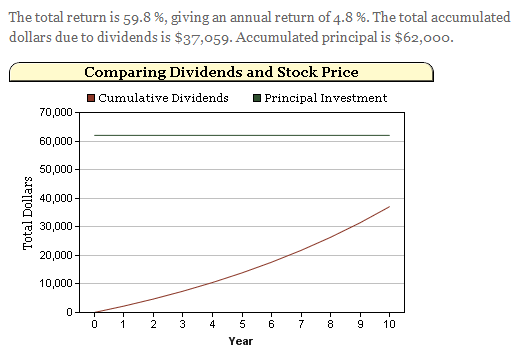When I look for dividend paying stocks for the long run, a few of the characteristics I like to see are a reasonable dividend yield of at least 2.5%, a history of consistent dividend growth, and earnings that do not plummet every time there is an economic downturn. Procter & Gamble (PG) fits this bill perfectly.
PG Profile*:
The Procter & Gamble Company, together with its subsidiaries, provides consumer packaged goods and improves the lives of consumers worldwide. The company operates through six segments: Beauty, Grooming, Health Care, Pet Care, Fabric Care and Home Care, and Baby Care and Family Care.
*Profile taken from Yahoo Finance.
| PG: |
| Div Yield | 1 Yr Div
Growth Rate | 5 Yr Div
Growth Rate |
| 3.60% | 7% | 10% |
| Payout Ratio | Debt to Equity |
| 64% | 50% |
With a solid dividend yield of 3.6% and five year annual dividend growth of 10%, P&G is most definitely a dividend growth stock that is worth a look. Digging even deeper we find that P&G has never cut their dividend since starting their payout in 1970. To add to their resume, the company actually saw Earnings Per Share (EPS) and their dividends grow throughout the tough recession years in 2008 and 2009. A non-cyclical company that can maintain earnings even in recessions is much more able to keep a growing, or at least consistent, dividend over time.
If there is a negative for this company it’s that their payout ratio is a little higher than I would like to see. Also, their debt to equity at 50% is worth keeping an eye on. If their debt keeps ticking up the odds of them cutting their dividend in a serious credit contraction will go up.
Let’s take a look at what the future may hold if one invests in P&G. It’s important to analyze scenarios for such a company where we look at both the dividend yield and growing dividends. I ran the following scenario on our publicly available calculator called Total Returns- Dividends Vs. Price Appreciation. If we buy 1,000 shares today, apply a dividend growth rate of 7% over the next 10 years, reinvest dividends, and assume the price of the stock does not change, we get the following:
| Inputs: |
| Investment | Dividend Yield | Growth of
Dividend (Annual) |
| $62,000 | 3.6% | 7% |
| Outputs: |
| Total Return | Annual Return | FV Dividends | FV Investment |
| 60% | 4.8% | $21,518 | $62,000 |

The annual total return, even if the stock price doesn’t budge, would be nearly 5% while the total return over the 10 year time period would be 60%.
What if an investor holds Procter & Gamble for 20 years in a retirement portfolio and collects the dividends over this time frame without any increase in the stock price?
| Outputs: |
| Total Return | Annual Return | FV Dividends | FV Investment |
| 227% | 6.1% | $81,806 | $62,000 |
An annual return of 6.1% with no increase in the stock price is not too bad in today’s investing world. It simply shows the power of growing dividends over time.
Dividend growth stocks can help a retirement plan immensely, especially vs. low-yielding treasury bonds. I plugged in the 4.8% total return figure I found in our first example into our retirement planner in place of the ten treasury bonds that were in the portfolio before.
I found that if a typical 55 year old couple with $400,000 in assets moves 50% of their funds from treasuries to dividend payers that give them a 4.9% return, over ten years they will have increased the time that their funds last in retirement by over 10 years.
I believe that investing in Procter & Gamble today for the long run will pay off due to their consistent and growing dividends. Scenarios such as the ones I’ve run here can help investors understand the power of dividends over time, especially when those dividends are growing.